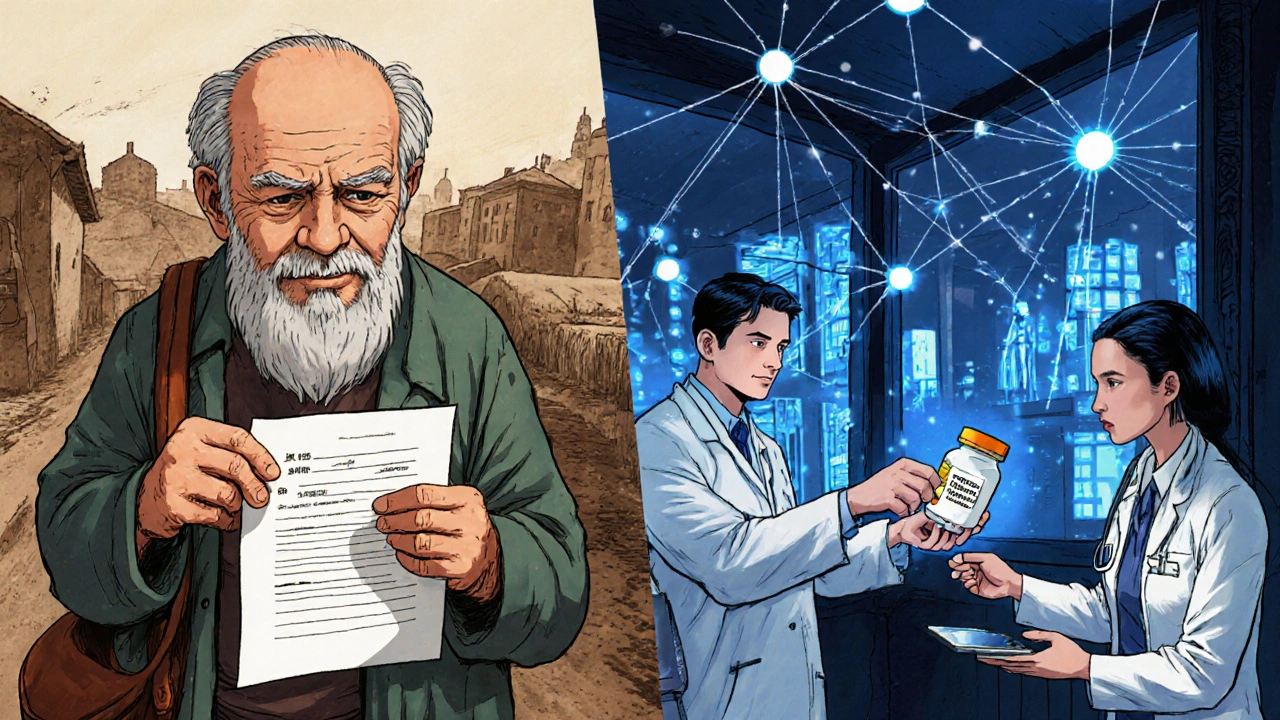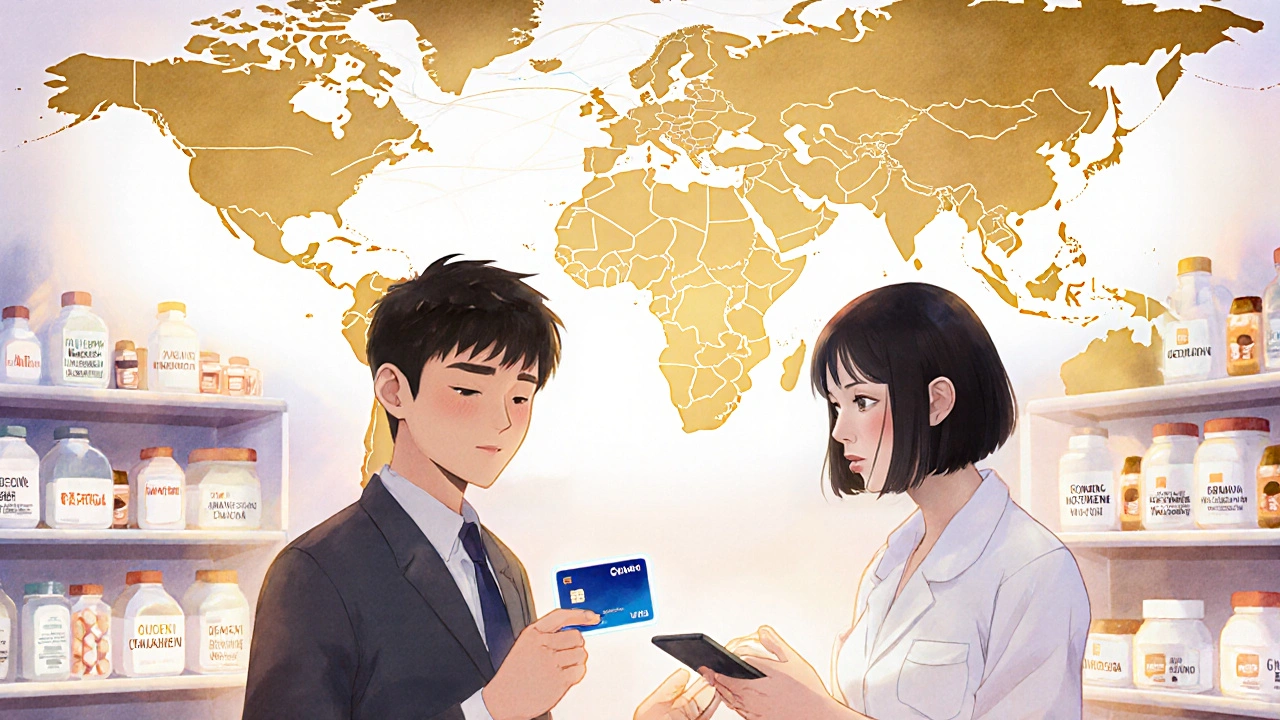Imagine needing your regular blood pressure medication while on vacation in Spain. Your prescription is digital, issued in Germany. You walk into a local pharmacy in Barcelona, show your ID, and walk out with your pills-no paperwork, no delays. This isn’t science fiction. It’s happening right now across the European Union, thanks to a system called ePrescription and eDispensation.
How Cross-Border Pharmacy Services Actually Work
The EU’s cross-border pharmacy system lets patients get medications from pharmacies in other member states using digital prescriptions. It’s built on the eHealth Digital Service Infrastructure (eHDSI), also branded as MyHealth@EU. This isn’t just a website-it’s a secure network connecting national health systems in 27 EU and EEA countries. Iceland will join by August 31, 2025, completing the full map.Here’s how it works in practice:
- You get a digital prescription from your doctor at home-say, in Austria.
- You travel to France and visit a pharmacy there.
- You log into the French pharmacy’s system using your national e-ID (like Austria’s e-Card or France’s Carte Vitale).
- The pharmacy accesses your ePrescription through the EU-wide network.
- You receive your generic medication, same as you would at home.
This system doesn’t just handle prescriptions. It also shares your Patient Summary-a short, translated document listing your allergies, current meds, and past conditions. This cuts down on errors when language or medical records don’t match up.
Why Generic Drugs Are the Key to This System
Generic drugs are the backbone of cross-border mobility because they’re identical in active ingredients to brand-name versions but cost far less. In many EU countries, generics make up over 70% of prescriptions. That’s why the system was built around them.When you get a generic drug in Italy, it’s the same compound as the one in Poland or Portugal. The packaging might look different. The inactive ingredients might vary slightly. But the active part? Same. That’s what regulators require.
Because generics are interchangeable, they’re perfect for cross-border use. No need for special approvals. No complex reviews. Just a digital prescription and a pharmacy that’s connected to the network.
But here’s the catch: not every pharmacy is connected. Only pharmacies registered in the eHDSI network can process cross-border ePrescriptions. That means if you’re in a small town in Romania or Slovenia, the local pharmacy might still only accept paper prescriptions.
Where It Works Best-and Where It Falls Apart
The system works best in border regions. Take the Netherlands-Germany border. People live in one country, work in another, and get their meds in either. A 2025 survey found 78% of patients in these areas successfully filled cross-border prescriptions.But outside those zones? Only 42% of patients report success. Why?
- Some countries haven’t fully rolled out ePrescription systems.
- Pharmacists aren’t trained to handle foreign prescriptions.
- Patients don’t know they’re allowed to do this.
According to Eurobarometer, only 38% of EU citizens know they have the legal right to get their meds abroad. That number jumps to 72% in border areas where people use the system regularly.
Even worse, some countries have rules that block access entirely. Ireland, for example, won’t fill prescriptions from UK-based telehealth services-even if the doctor is licensed and the prescription looks valid. Pharmacists are required to check how the consultation happened. If it was online, they can refuse.

Regulatory Chaos Is Still a Real Problem
The EU has rules. But each country implements them differently. That’s where things get messy.Italy replaced paper prescription stickers with GS1 DataMatrix codes in February 2025. That’s a scannable barcode that holds prescription data. But if you’re from Spain and try to fill a prescription in Italy, your pharmacist might not know how to scan it.
Only 8 EU countries have clear rules for how pharmacists should handle e-pharmacy prescriptions. That means in countries like Greece or Hungary, pharmacists are flying blind. They don’t know if they’re breaking the law by filling a foreign ePrescription-or if they’re required to.
The European Commission’s Regulation (EU) 2025/327 gives them the power to shut down non-compliant services. But enforcement is slow. And until every country has the same training, tools, and rules, patients will keep hitting walls.
What’s Changing in 2025 and Beyond
2025 is a turning point. Three major changes are reshaping the landscape:- The Critical Medicines Act now requires drugmakers to report supply shortages in real time. This helps prevent gaps when a generic runs out in one country but’s still available in another.
- The European Shortages Medicines Platform (ESMP) is now live. It’s a centralized dashboard showing where medicines are running low across the EU. Pharmacies can use it to redirect patients to nearby countries with stock.
- Health Technology Assessment (HTA) Regulation is making it easier for generic drugs to get approved across borders. Instead of 27 separate reviews, there’s now a shared evaluation process.
These aren’t just paperwork changes. They’re fixing real problems. For example, before the ESMP, a patient in Lithuania needing a rare generic for epilepsy might wait weeks because no local pharmacy had it. Now, the system flags that the same drug is in stock in Latvia-and the pharmacist can arrange delivery.

What Patients Need to Know Before Trying This
If you’re thinking about using cross-border pharmacy services, here’s what you need to do:- Confirm your country has ePrescription enabled. Germany, France, Austria, Spain, and the Netherlands are fully live. Others are partial.
- Ask your doctor to issue a digital prescription. Paper ones won’t work abroad.
- Make sure your national health portal is set up for cross-border data sharing. You may need to manually approve which countries can access your records.
- Call the pharmacy ahead of time. Ask if they accept ePrescriptions from your country. Don’t assume.
- Bring your EU health insurance card (EHIC) and ID. You might need both.
And remember: this system only works for prescriptions issued within the EU/EEA. UK prescriptions are not valid in Ireland. Swiss ones aren’t accepted in Poland. Stick to EU-issued ones.
Why This Matters for Your Health
This isn’t just about convenience. It’s about access. In rural areas, pharmacies are closing. In aging populations, chronic disease meds are needed daily. When you can’t get your drug locally, your health suffers.Studies show cross-border pharmacy services reduce medication errors by 22% and improve chronic disease compliance by 17%. Why? Because patients aren’t skipping doses because they can’t find their meds.
For people with rare conditions, it’s life-changing. A patient in Finland needing a specific generic for multiple sclerosis might find it only in Sweden. Without this system, they’d have to fly there just to pick up a bottle. Now, they can get it at the corner pharmacy.
The EU’s goal is to cut medication access disparities by 35% by 2030. That’s possible-but only if every country catches up. Right now, it’s a patchwork. Some places are ahead. Others are still on paper.
What’s Next for EU Cross-Border Pharmacy
By 2027, the system will expand to include lab results, medical images, and hospital discharge summaries. That means your doctor in Portugal could see your MRI from Sweden. Your pharmacist in Denmark could know about your recent surgery in Belgium.The next phase is full electronic health records. Not just prescriptions. Not just summaries. Your full medical history-accessible, with your permission, across borders.
But progress depends on political will. The European Association of E-Pharmacies warns that without coordinated action, digital inclusion will stay uneven. Some countries will thrive. Others will fall behind.
For now, if you’re in a country with ePrescriptions and you need a generic drug, you have more options than ever. You just need to know how to use them.
Can I get my prescription filled in another EU country if I’m just traveling?
Yes, as long as your country and the country you’re visiting both participate in the ePrescription system. You need a digital prescription issued by a doctor in your home country, and you must have your national e-ID to access it at the foreign pharmacy. Paper prescriptions won’t work.
Are all generic drugs available across borders?
No. While the active ingredients are the same, not every generic version is approved or stocked in every country. Some countries have different manufacturers or formulations. The ePrescription system will show what’s available locally, but you might need to switch to a different brand if your usual one isn’t in stock.
Can I use a UK prescription in an EU pharmacy?
In most cases, no. The EU does not recognize prescriptions from the UK, even if they’re from a licensed doctor. Ireland, for example, explicitly blocks them. Some countries might accept them in emergencies, but this is rare and not guaranteed. Always get a new prescription from an EU doctor if you’re staying long-term.
Why do some pharmacies refuse to fill my foreign ePrescription?
Many pharmacists still don’t know how to use the system, or their pharmacy hasn’t been trained. Some countries haven’t updated their rules, so pharmacists fear legal risk. Others can’t access your country’s ePrescription portal because of technical gaps. Always call ahead and ask if they handle cross-border ePrescriptions.
Do I pay the same price for a generic drug in another EU country?
No. Prices vary by country. You’ll pay the local price, which might be higher or lower than at home. If you’re covered by your home country’s health insurance, you may be reimbursed after you pay. Check with your insurer before you go.





